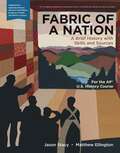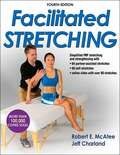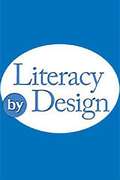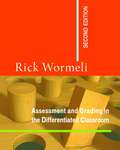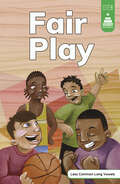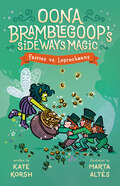- Table View
- List View
FRSR Part I
by Muthuswamy Brinda SanjeevFor the sake of convenience of the readers and facility of easy handling, the compilation is being brought out in four parts. The first part contains the Fundamental Rules and Supplementary Rules excluding rules regarding Travelling Allowances, and the related Appendices. The second part contains the Supplementary Rules — Travelling Allowances and the related Appendices. The chapters on leave from both the Fundamental Rules and the Supplementary Rules which have become more of historic significance than of current application, have been deleted and in their place the Central Civil Services (Leave) Rules, 1972, has been brought out as Part-Ill of this compilation, complete in itself with all relevant Government of India decisions and administrative instructions. Part-IV contains all general orders issued up-to-date on Dearness Allowance, Dearness Relief to Pensioners and exgratia to CPF Beneficiaries, House Rent Allowance, Tough Location Allowance, etc., the stations covered for these purposes and the details of Urban Agglomeration as per 2001 Census.
FRSR Part III
by MuthuswamyAn up-to-date, comprehensive, self-contained and reliable reference compendium on CCS (Leave) Rules, 1972, presented in an easy-to-refer manner with brief meaningful headings for Government decisions. Recommendations of the Seventh Pay Commission Report accepted by the Government incorporated. Orders regarding CL, Special CL in a separate Appendix. All orders, audit instructions and decisions in FRs, SRs and RLRs not codified so far, included. An indispensable reference book for use in all Central Government Offices.
FRSR Part IV Competitive Exam
by MuthuswamyAs usual the main rules are given in antique type and Government orders and Audit rulings in Roman type with appropriate headings so as to enable the readers to pick out the relevant decisions without any difficulty. The chapter alignment and rule numbers are the same as in the Government compilation. For any subsequent corrections/amendments, readers are advised to subscribe to our monthly journal Swamy news wherein we reproduce the latest orders issued by Government on service and financial rules.
Fabric of a Nation: A Brief History With Skills And Sources, For The AP® Course
by Jason Stacy Matthew EllingtonNIMAC-sourced textbook
Face Painting (Fountas & Pinnell Classroom, Guided Reading Kindergarten)
by Kristen KunkelNIMAC-sourced textbook
Faces and Places in America
by Deborah J. Short Tomas Fernandez Tony BonaventureNIMAC-sourced textbook
Faces in Strange Places (Fountas & Pinnell Classroom, Guided Reading)
by Alan KazarNIMAC-sourced textbook
Facilitated Stretching (4th Edition)
by Robert McateeFacilitated Stretching, Fourth Edition, remains the most trusted resource for proprioceptive neuromuscular facilitation (PNF) stretching, an effective and easy-to-use method that involves stretching the muscle, contracting it isometrically against resistance, and then stretching it again to increase range of motion. Featuring a full-color interior, streamlined organization, the fourth edition brings PNF stretching beyond the treatment room with the inclusion of techniques for the gym, workout room, and home. The fourth edition offers a visual demonstration of PNF stretching techniques with more than 320 photos and illustrations. It includes these updates: - A full-color interior provides readers with clear images of the techniques discussed - Graphic elements on selected photos highlight the muscles being stretched as well as the isometric effort for the stretcher and the partner - Reorganization streamlines the content into two parts, first focusing on the basics and then covering stretches - Expanded content demonstrates how to incorporate stretches, including strengthening routines, into nontherapy workouts to optimize functional training - An appendix showcases anatomical planes of motion, anatomical terms, and types of joints - Online high-definition video presents both treatment room techniques and simplified PNF stretches for nontherapy settings "Facilitated Stretching, Fourth Edition," examines techniques and guidelines for PNF stretches in a variety of settings. Stretches are demonstrated on a treatment table, mat on the floor, chair, cable-pulley machine, and weightlifting bench. Stretches are grouped according to each joint, and the majority of the stretches include both a partner stretch version and a self-stretch version.
Fact or Fantasy: Science 4. 1 Animal Tales (Panorama)
by Joyce McGreevy G. K. GilbertNIMAC-sourced textbook
Fact or Opinion Reading Comprehension Book: Reading Level 3.5-5.0
by EdupressThis resource is an effective tool for instruction, practice, and evaluation of student understanding. It includes ideas on how to introduce fact or opinion to students, as well as activities to help teach and practice the concept.
Fair Isn't Always Equal: Assessment and Grading in the Differentiated Classroom
by Rick WormeliDifferentiated instruction is a nice idea, but what happens when it comes to assessing and grading students? What's both fair and leads to real student learning? An internationally recognized expert on grading practices, Rick Wormeli first examined these questions 10 years ago in the first edition of Fair Isn't Always Equal. In this thoroughly updated second edition, Rick provides a catalyst for serious reflection on current grading and assessment practices in differentiated classrooms. Coherent and effective standards-based grading practices for a high-stakes, accountability-focused world is also outlined. Recognizing the importance of having a shared school vision for assessment and grading, Rick addresses the challenges for teachers and administrators alike. Middle- and high-school educators will easily recognize real examples and gray areas of grading. Rick tackles important and sometimes controversial assessment and grading issues constructively, incorporating modern pedagogy and the challenges of working with diverse groups of students. New sections address sports eligibility, honor roll, descriptive feedback techniques, and gifted/talented students, and chapters on test questions, redos/retakes, grading scales, and grading effort and behavior have been revised extensively. This important book clearly explains the principles behind best grading practices so that you're ready for all grading questions or scenarios that you may encounter in your classrooms and schools.
Fair Play (Stairway Decodables Step 6)
by Leanna KochPlaying basketball in the gym after school is a blast! But when a new friend joins the group, his constant fouls ruin the game for everyone. Will the boys find a way to make basketball fun again? Stairway Decodables is a supplemental phonics resource that’s perfect for supporting small group instruction, independent reading, or reading practice at home. This title provides practice in decoding words with vowel-r combinations.
Fair and Square: An Acorn Book (Unicorn and Yeti #5)
by Heather Ayris BurnellMagical friends Unicorn and Yeti learn what it means to play fair -- in fun and unexpected ways!Pick a Book. Grow a Reader!This series is part of Scholastic's early reader line, Acorn, aimed at children who are learning to read. With easy-to-read text, a short-story format, plenty of humor, and full-color artwork on every page, these books will boost reading confidence and fluency. Acorn books plant a love of reading and help readers grow!Yeti thinks triangles are the best shape.But which shape is Unicorn's favorite? Unicorn paints a beautiful picture.Yeti worries his painting isn't as nice.Yeti baked a pie to share with his friend. What is the most-fair way to split the pie?Best friends Unicorn and Yeti have lots of fun in these laugh-out-loud stories. With full-color artwork and easy-to-read text throughout, this adorable book is perfect for new readers!
Fairies in the Garden (Fountas & Pinnell Classroom, Guided Reading)
by Fabio Leone J. C. KaneNIMAC-sourced textbook. A Very Long Joke. Many years ago, two girls played a joke. They thought their prank would last just a few hours. But they ended up fooling some people for almost 70 years.
Fairies vs. Leprechauns (Oona Bramblegoop's Sideways Magic)
by Kate KorshThe third book in the hilarious chapter book series about Oona the Underwear Fairy, where Oona has to figure out who is stealing the Tooth Fairy's gold. Text and illustrations printed in green! Underwear Fairy, Oona Brambelgoop, and her friends Horace and Lucy (the Tooth Fairy) are trying their hardest to prove they are responsible citizens of Fairydom, and catching the culprit of the great glitterberry warehouse theft is the perfect way to do it. But when the leprechaun gold Lucy has given kids for their teeth also goes missing AND she starts to lose her magic, the friends realize this must be about more than just berries. It turns out Lucy has been manipulating magic to get more gold and the leprechauns are not happy! Oona will have to use all the creativity she can muster to stand up to the leprechauns and save Lucy&’s job. Can she restore harmony between the two magical communities before Lucy loses her magic for good? Packed with Fun Fairy Facts, humor, and lots of heart, this magical series celebrates finding friendship and your place in the world, even if you fit in a little sideways.
Fairy Dreams (Barbie)
by Mary Man-KongGirls ages 4-6 will love learning to read on their own with this Step 2 Step into Reading leveled reader based on Barbie's latest film.
Fairy Hill: Fairy Hill #1) (Scholastic Reader, Level 1)
by Cari MeisterMeet the magical fairies of Fairy Hill!Fairy Hill is a magic forest where fairies live, play, and have lots of sparkly adventures in this Level 1 reader series! Ruby, Luna, and May are best friends. These young fairies are all looking forward to earning their big wings from the Fairy Queen. But first they each have to do something extra kind or brave. In book #1, Ruby, May, and Luna discover that Fairy Hill's magic garden has lost its sparkle! The fairies try everything to make the garden shine again, but nothing works. Then, a lost baby deer comes to the garden for help. The only way to help it find its way home is to feed it magic clover. Then Ruby has an idea! Will she be able to fix the garden and help the baby deer? Will the Fairy Queen visit the fairy friends?
Fairy Hill: Fairy Hill #2) (Scholastic Reader, Level 1)
by Cari MeisterIt's time for another adventure in Fairy Hill!Fairy Hill is a magic forest where fairies live, play, and have lots of sparkly adventures in this Level 1 reader series! Ruby, Luna, and May are best friends. These young fairies are all looking forward to earning their big wings from the Fairy Queen. But first they each have to do something extra kind or brave. In book #2, a magic shell goes missing! Without it, the glow globes that light up Fairy Hill will all go dark -- and the Fairy Queen will have to cancel the Fairy Ball! Luna, Ruby, and May go looking for the shell. They find out a chipmunk is using it to light his tree. Luna has an idea to get the shell back! Will she be able to bring the light back to Fairy Hill before the ball?

